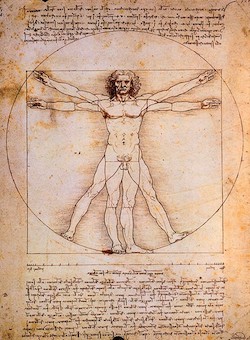
The author of what is thought to be the first book on architecture was a first century BCE Roman architect named Marcus Vitruvius Pollio. His De Architectura Libri Decem (Ten Books on Architecture) carefully described existing practices, not only in the design and construction of buildings, but also in what are today thought of as engineering disciplines. His books include such varied topics as the manufacture of building materials and dyes (material science), machines for heating water for public baths (chemical engineering), amplification in ampitheaters (acoustics), and the design of roads and bridges (civil engineering). His writing is prescriptive and gives direct advice: “I have drawn up definite rules to enable you, by observing them, to have personal knowledge of the quality both of existing buildings and of those which are yet to be constructed.”
Leonardo da Vinci drew Proportional Study of Man in the Manner of Vitruvius in about 1487 CE as an illustration for a book about Vitruvius. The drawing depicts a “man of perfect symmetry” as described by the architect.
What better subject to be the namesake of a Masonic Lodge? The first published author on architecture, who had a vision of what comprised the ideal man.
Lodge Vitruvian hopes to improve the quality of both existing Masons and those which are yet to be created.
